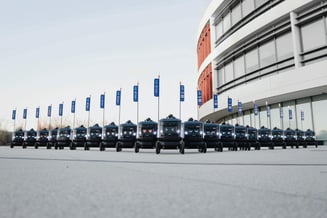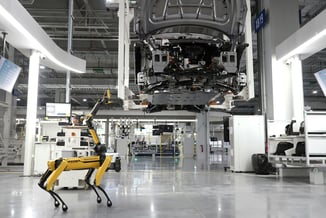Robots aren't simple assets. They are complex systems composed of motors, sensors, controllers, firmware, and other components that constantly change over time as specific modules are upgraded or swapped. For robotics companies that lease or maintain fleets, that complexity creates one big problem: it becomes hard to know exactly what’s where, what’s working, and what’s not.
When data sits in static lists like spreadsheets or database tables that aren't kept up to date, the picture quickly blurs. Details go missing. Service history becomes unreliable. Components get swapped but records aren't updated. Over time, you lose traceability and spend more money fixing problems that could have been avoided.
Digital twins fix that. They create a live digital version of every robot and its components, with guardrails and automations to help ensure changes are reflected in the digital system as the physical asset changes. It’s a more accurate, more connected way to manage robots at scale. And it’s fast becoming the foundation of modern robot asset management.
What a digital twin means in robotics
A digital twin is a structured, real-time version of a robot that mirrors what’s happening in the field. It brings together three types of data:
-
Static data such as serial number, model, configuration, and installation date.
-
Context data such as who owns it, which site it’s at, and what contract it’s under.
- Live data such as usage hours, fault alerts, temperature or battery status.
This isn’t a simulation or 3D model. It’s a living record of every robot you build, lease, or maintain. When handled inside a proper robot asset management system, that data becomes easy to use. You can see which robots are due for service, which are underperforming, and which are costing more than they should.
Why component-level twins matter
Every robot you send out into the world contains dozens of replaceable components. Motors wear out. Sensors drift. Batteries degrade. When you don’t track these individually, you lose visibility of what’s inside each robot and when it was last changed.
Component-level twins add that missing layer. Each major part is tracked as its own digital twin, linked to the robot it belongs to. When a part is replaced, the record updates automatically. Over time you can see how long components last, which models perform best, and which environments cause faster wear.
That insight lets you improve maintenance planning and product design. It also saves money by extending the lifespan of both robots and their parts.
Real-time visibility protects uptime
When telemetry from the field feeds into a digital twin, problems become visible before they cause downtime.
If a battery runs hot or a motor draws more current than usual, the twin changes status and the system triggers a maintenance task. Your service team can fix issues early and keep the customer’s robot working.
This kind of live visibility level-ups modern robot asset management. It keeps fleets productive, protects uptime commitments, and reduces the stress of chasing faults after they happen.
Reducing waste through data insight
When new components are implemented on certain robots, asset management systems can help you assess whether those robots display better or worse reliability or other key metrics. It helps you feel confident to invest in new module lines and spot potential issues earlier to reduce capital spending on a series of modules that won't meet their requirements.
The same can be said of maintenance procedures. With a history of maintenance connected to every digital twin patterns begin to emerge. Perhaps a specific engineer is doing something different when maintaining a specific component that extends overall robot lifetime that bit longer and everyone can learn from them. Or perhaps two different module failures back to back is a clear indication that a robot chassis is reaching the end of its useful life and needs to be retired. Without the data on hand, these patterns cannot be spot.
Building digital twins in practice
Building digital twins is simpler than it sounds. It starts with structure.
-
Define the hierarchy and the level you want to go down to: robot → module → component → subcomponent.
-
Decide what static, context, and live data each item needs.
-
Connect live data feeds through APIs or telemetry.
-
Create automations for your digital twins that help you keep them updated. For example, if a module goes down, the status of its parent robot should reflect that issue too.
In Starhive, you can model every robot and link its parts down to as many levels as you like. You decide how deep the data goes, and you can create as many automations and notifications to help keep your data accurate.
Final thoughts
Digital twins turn scattered asset or component data into a connected, accurate view of your fleet. They make it easier to manage uptime, plan maintenance, and protect capital.
For robotics companies leasing or maintaining robots, this isn’t a futuristic idea. It’s a better way of working today, one that builds reliability into every robot you deliver.
.png)



